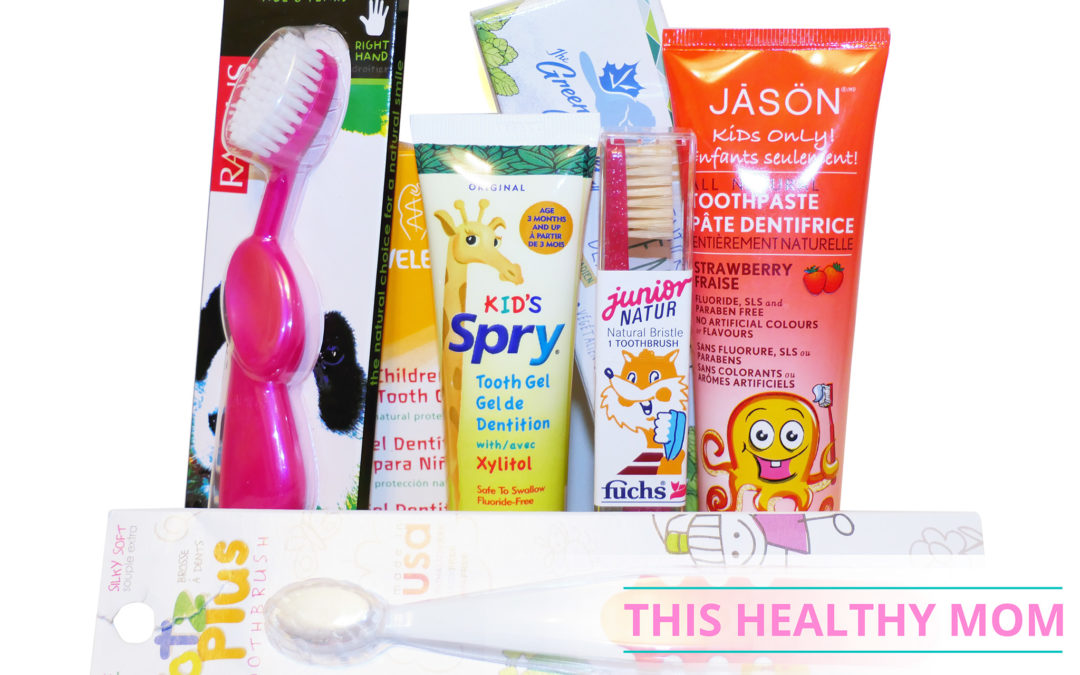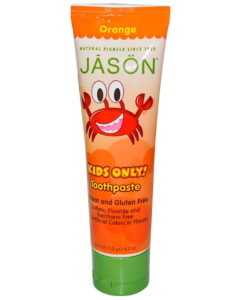Growing up in a health food family we never had any of the common toothpaste brands in our house. We were the kids who had the big words in red marker on our dental files NO FLOURIDE. So when my own kids starting going to the dentist I was surprised that not much had changed since I was a child. They are still giving out toothpaste full of unhealthy ingredients in the ‘goody bag’ kids receive. Toothpaste ingredients are probably not something most of us would think about. We assume that all the ingredients in a kid’s toothpaste are safe because why would our government or a manufacturer be allowed to sell a product that babies, toddlers and children will undoubtedly eat that could be harmful?
For children under age three, Health Canada recommends only a rice sized amount of toothpaste be used. For children three to six years old they recommend a pea size amount of toothpaste. And it is recommended that toothpaste not be swallowed. Children under six often love to eat the toothpaste and if given a chance would probably eat it right out of the tube! A toothpaste with the warning DO NOT SWALLOW on the label shouldn’t be marketed or used by children.
Sadly, when it comes to toothpaste, not all products are created equal. Navigating the ingredients on a toothpaste label and understanding the government safety regulations are something that a parent should not have to do. What I found out will most likely shock and disappoint you.
The membrane lining of the mouth has an absorption efficiency of more than 90% which means when we brush our teeth, we are brushing our gums as well and even if we do not swallow the toothpaste it is still entering our bloodstream through our gums. Our mouth is the first step in our digestion. What goes into our mouth makes it into our body and we all know our kids eat that toothpaste. Let’s look at what they are really eating:
Toxic Offenders in Kids Toothpaste
• Fluoride: Too much fluoride causes fluorosis (white spots on your teeth) and has been linked to other health conditions like preventing the proper function of your thyroid. Health Canada doesn’t even recommend children from birth to three years of age use fluoride toothpaste unless a dentist believes there may be a risk of dental decay.
• Sodium Lauryl Sulfate (SLS): This ingredient is responsible for the foaming action of our toothpaste. My husband thought “the bubbles meant the toothpaste was working”. Not so, the bubbles do not make your toothpaste function better. SLS has been linked to the development of canker sores. SLS also changes the way your taste buds work. This is why everything tastes bad after you brush your teeth. SLS is an unnecessary chemical that should not be in any toothpaste let alone your children’s toothpaste.
• Artificial Dyes and Colors: As the question where does the color of the toothpaste come from? To make the blue or red stripe that is so perfectly placed in the middle of the toothpaste manufacturers add food colouring. These food colours are made from petroleum products. Red 40, Yellow 5 and Yellow 6 are the worst according to this report which covers the dangers of food colours “Rainbow of Risks”. Some of these food dyes come with side effects like hyperactivity in children and hypersensitivity reactions.
• Titanium Dioxide: To make toothpaste white titanium dioxide is added. It is also found in supplements, added to foods and to make paint white. Titanium dioxide is in the hot seat these days as its safety is being reviewed.
• Synthetic Flavours: To give your kids toothpaste a bubble gum flavor, synthetic flavors are added. Often the label doesn’t state what type of flavor or the source of the flavor that has been added. Flavors made in a laboratory with chemicals are not what I want in my children’s toothpaste.
Choose toothpaste based on the ingredients and not by the kid friendly marketing on the tube
What does Health Canada Say?
Health Canada approves the ingredients in toothpaste to ensure that it contains ingredients that are safe and effective. Titanium dioxide, fluoride, sodium lauryl sulfate, artificial colors and synthetic flavours are approved by Health Canada BUT as safe as long as you only put a rice or pea size amount on the toothbrush and your child doesn’t swallow it. What I have found is that common children’s toothpaste brands do not state this.
My Favorite Toothpaste Brands
There are many healthy, non-toxic alternatives to standard mainstream toothpaste brands. Some have natural flavours and some have no flavour at all, no SLS, no titanium dioxide, no fluoride, no harmful ingredients whatsoever. Kids have different likes and wants. We parents just want our children to brush their teeth without a fight. Our top two favourite brands are Spry and Jason. My kids love the taste, I love the ingredients making them a win in this house.
What is Your Toothbrush Made Of?
Now that we know what’s lurking in our toothpaste let’s talk about the toothbrush. Standard toothbrushes are made of plastic with bristles made from synthetic nylon fibers which can contain BPA an endocrine (hormone) disrupter. Many children chew their toothbrush so whatever it is made of will break down and end up in the body. Toothbrushes are now available made from natural substances like Bamboo eliminating the plastic altogether. When the first tooth pops through use a washcloth and wipe the teeth daily or use a natural bristle baby toothbrush. I started with the Green Sprout Silicone Baby Toothbrush. My daughters just chewed on them to start but any action on their teeth help
I came across a company that has a toothbrush that does not require toothpaste at all! Therawise natural antibacterial toothbrush bristles are made from nylon blended with naturally occurring minerals. Another beneficial feature of the brush is the ability to selectively eliminate pathogenic bacteria like Escherichia coli, Staphylococcus and Pseudomonas aeruginosa. Your teeth feel clean and smooth after using it and is perfect for on the go.






